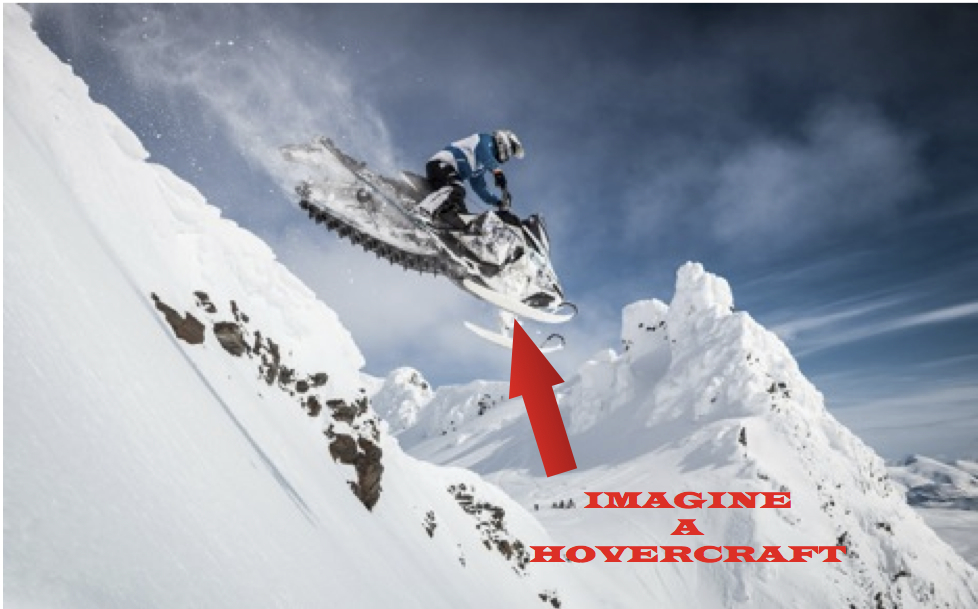Project 2: Escape from Ice Station McMurdo
Parts A and B: backstory from previous class period (not computational)
(Skip ahead to Part C for the computational portion of the project. What follows is simply the project's storyline.)
You are a member of a scientific research team at McMurdo ice station which is funded by the Carver Media Group in Antarctica. For reasons undisclosed, several inhabitants of the ice station have disappeared. Frightened, a member of your team decides to flee the station on a fan powered hovercraft but you receive a distress call not long after their escape that their steering and acceleration controls have been jammed and they need your help.
You decide to attempt a rescue in another hovercraft. You need to tell the runaway researcher when to jump onto your hovercraft. Just as you are about to radio the time to jump to the runaway researcher, you realize the steering and acceleration controls have become frozen on your hovercraft and so it continues to accelerate and you cannot change direction. $200$ meters ahead of the point at which you were going to tell the researcher to jump is an ice ravine. At the bottom of the ice ravine, $400$ meters below, is an unfrozen salt water pool surrounded by stalagmites. From the ravine's edge to the pool is $490$ meters and the pool stretches for $900$ meters. You are moving too quickly to survive jumping off the hovercraft, but might survive the fall into the pool by staying on the hovercraft – it has seat belts. You now have a choice to make: stay on your hovercraft or jump to the runaway researcher's hovercraft. One or both may make it to the pool. Your choice may be the difference between life and death.
Part C: computational modeling of the trajectories of the hovercrafts
Surprisingly enough hovercrafts are an expensive piece of kit. Your employer, the Carver Media Group, is concerned by the happenings at the McMurdo ice station and would like you to produce an accident report detailing the events after you lost control of your hovercraft. The accident report should include a detailed computational model that provides the projected motion of the runaway hovercraft.
To begin, copy the code below into a glowscript file. Follow the link for details: Getting Started with Glowscript.
#get_library("https://raw.githubusercontent.com/perlatmsu/physutil/master/js/physutil.js")
#Objects
cliff = box(pos=vector(-100,0,0), size=vector(200,800,0), color=color.white)
ravine = box(pos=vector(245,-200, 0), size=vector(490,400,0), color=color.white)
lake = box(pos=vector(940, -200, 0), size=vector(900,400,0), texture=textures.rough, color=vector(0.1,0.5,1))
runawaycraft = sphere(pos=vector(-200,400,0), radius=10, color=color.red)
#Parameters and Initial Conditions
g = vector(0,-9.81,0)
b = 0 #Drag coefficient
runawaycraftm = 1500
runawaycraftv = vector(10,0,0)
runawaycraftp = runawaycraftm*runawaycraftv
#Time and time step
t=0
tf=5
dt = 0.01
#MotionMap/Graph
#runawaycraftMotionMap = MotionMap(runawaycraft, tf, 5, markerScale=1, labelMarkerOrder=False, markerColor=color.orange)
#Calculation Loop
while runawaycraft.pos.x < 0:
rate(500)
Fgrav = runawaycraftm*g
Fground = -Fgrav
Fnet = Fgrav + Fground
runawaycraftp = runawaycraftp + Fnet*dt
runawaycraft.pos = runawaycraft.pos + (runawaycraftp/runawaycraftm)*dt
#runawaycraftMotionMap.update(t, runawaycraftp/runawaycraftm)
t = t + dt
Project 2: Learning goals
- Predict the motion of a single-particle system executing constant velocity or constant acceleration motion using appropriate representations (this includes verbal, graphical, diagrammatic, mathematical, and computational representations).
- Collect, analyze, and evaluate data to determine the type of motion and the properties of the motion of a single-particle system.
- Evaluate the applicability/limitations of models and the validity of predictions for different types of motion.
- Apply the momentum principle ($\Delta\vec{p}=\vec{F}\,\Delta t$; $d\vec{p}=\vec{F}\,dt$) iteratively/computationally to predict the motion or determine the properties of motion/net force acting on a single-particle system where the net force is not constant (e.g., due to spring-like restoring forces or dissipative drag forces).
